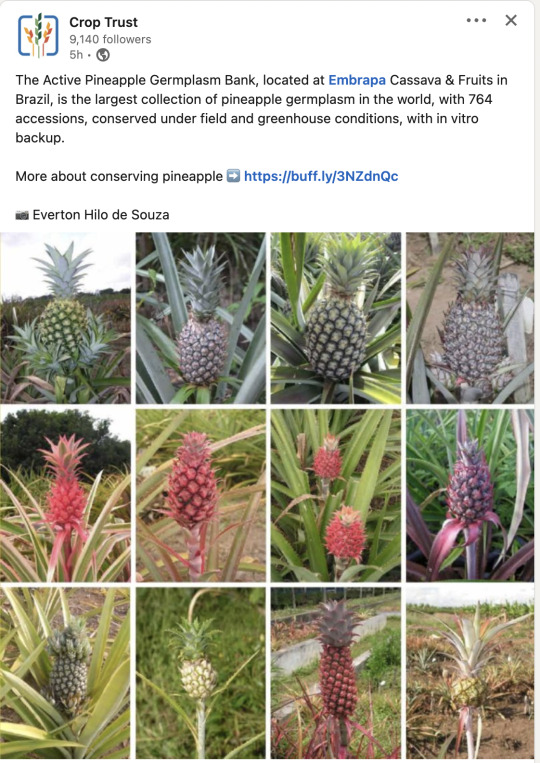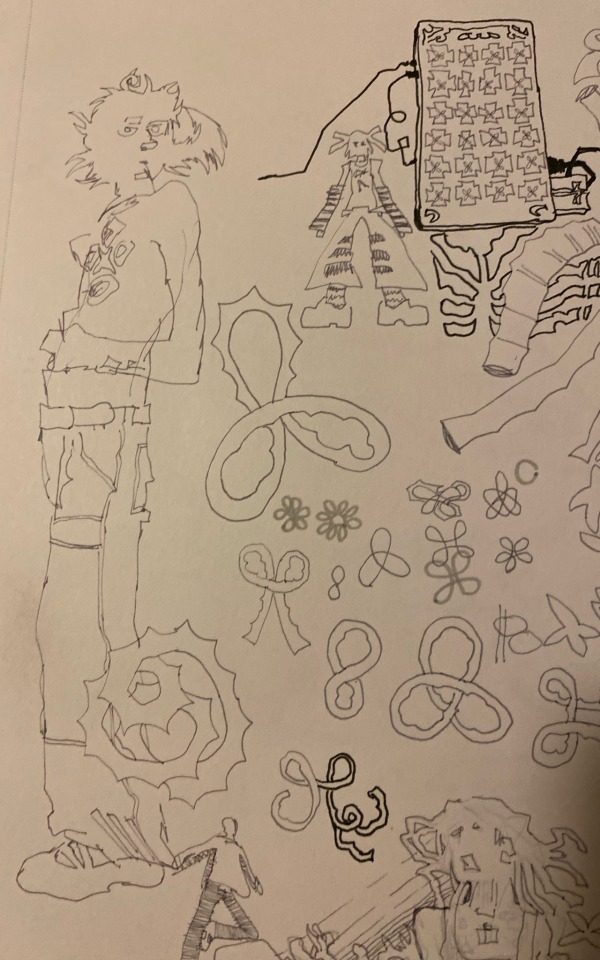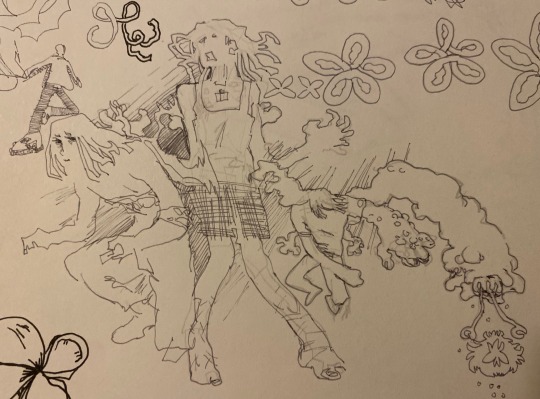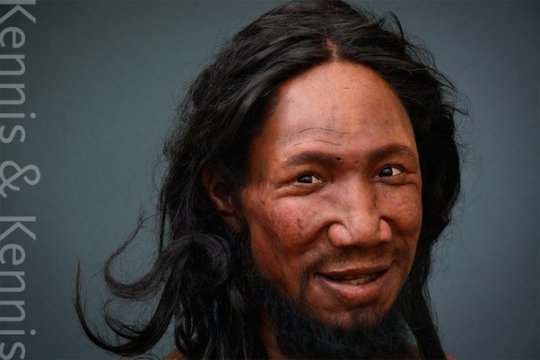#Genetic Diversity
Text
"Similar to the expeditions of a hundred or two hundred years ago, the Tara Pacific expedition lasted over two years. Its goal was to research the conditions for life and survival of corals. The ship crossed the entire Pacific Ocean, assembling the largest genetic inventory conducted in any marine system to date. The team's 70 scientists from eight countries took around 58,000 samples from the hundred coral reefs studied.
The first results of the analysis have now been published in Nature Communications. This largest-ever data set collection on coral reef ecosystems is freely available, and for years to come, will be the basis for elucidating the living conditions for corals and finding a way for them to survive climate change.
Important first results of the expedition show that global microbial biodiversity is much higher than previously thought. The impacts of the environment on evolutionary adaptation are species-specific, and important genes in corals are duplicated.
Global biodiversity ten times higher than assumed
Coral reefs are the most biologically diverse marine ecosystem on Earth. Although they cover only 0.16% of the world's oceans, they are home to about 35% of known marine species. Using a genetic marker-based data set, the researchers found that all of the globally estimated bacterial biodiversity is already contained in the microorganisms of coral reefs.
"We have been completely underestimating the global microbial biodiversity," says Christian Voolstra, professor of genetics of adaptation in aquatic systems at the University of Konstanz and scientific coordinator of the Tara Pacific expedition. He says the current estimate of biodiversity (approximately five million bacteria) is underestimated by about a factor of 10.
Impacts of the environment on evolutionary adaptation are species-specific
The 32 archipelagos studied serve as natural laboratories and provide a wide range of environmental conditions, allowing scientists to disentangle the relationships between environmental and genetic parameters across large spatial scales. This led to another important finding: The effects the environment has on evolutionary adaptation trajectories of corals are species-specific. To determine this, the researchers examined the telomeres, the ends of chromosomes that are the carriers of genetic information, for the first time.
In humans, the length of telomeres decreases during life; that is, with an increasing number of cell divisions, suggesting that biological age is closely linked to the length of telomeres. Researchers on the Tara Pacific expedition have now found that the telomeres in very stress-resistant corals are always the same length. "They apparently have a mechanism to preserve the lengths of their telomeres," Voolstra concludes...
Important genes are duplicated
Research data from the Tara Pacific expedition brought to light that the long life of some coral species may have yet another reason: the duplication of certain genes. Many important genes are present multiple times in the genome. The researchers were able to determine this through sequencing of coral genomes employing a new high-resolution technique.
This technique, called long-read sequencing, makes it possible to not only determine the set of genes present, but also to look at their order in the genome. According to Voolstra, the pervasive presence of gene duplication could be a possible explanation for why corals can live for thousands of years despite being exposed, for instance, to extreme UV radiation in shallow waters.
The entire data collection is freely accessible
All data sets are openly accessible and fully described with accompanying physical and chemical measurements to provide them as a scientific resource to all researchers.
"This is unique," Voolstra says. "It is the largest data set collection on coral reefs ever collected and it is completely open access." The aspiration is that this data collection will serve as a foundation and inventory to guide future study of coral reefs worldwide for many years."
-via Phys.org, June 26, 2023
#coral#coral reef#ocean#ocean conservation#biodiversity#microbiology#genetic diversity#genetic research#conservation#telomeres#genetics#climate change#evolution#ocean life#open access#good news#hope
400 notes
·
View notes
Text

The surprising diversity of Pineapples (Ananas comosus).
The Active Pineapple Germplasm Bank (Pineapple AGB) of Embrapa Cassava & Fruits (Embrapa/ CNPMF) has more than 700 accessions under field conditions. As backups, there are copies kept in a greenhouse, with one or two plants per accession, cultivated in plastic pots with commercial substrate. An in vitro gene bank was established in 2003, and during the past few years, several studies have been carried out to improve the in vitro conservation protocol. Currently, about 60% of the AGB’s accessions are preserved by this protocol. Another conservation strategy used is cryopreservation of shoot tips and pollen grains, with well-defined methods. One of the most significant advances in the pineapple germplasm conservation has been the implementation of a quality control system, which enabled to define standard operation procedures (SOP) towards a more efficient and safer germplasm conservation.
Source:
Vidigal Souza, Fernanda & Souza, Everton & Aud, Fabiana & Costa, Eva & Silva, Paulo & Andrade, Eduardo & Rebouças, Danilo & Andrade, Danilo & Sousa, Andressa & Pugas, Carlos & Rebouças, Érica & França, Beatriz & França, Rivã. (2022). Advances in the conservation of pineapple genetic resources at Embrapa Cassava and Fruits. 28. 28-33.
#katia plant scientist#botany#plant biology#plant science#plants#fruit#pineapple#pineapples#biodiversity#agriculture#conservation#genetic diversity#sustainable agriculture#tropical plants#science#biology
316 notes
·
View notes
Text
African populations today harbor more genetic diversity than any other population in the world, and the genetic diversity found in non-Africans represents only a subset of that found in Africa.
The claim has even been made that East Africans are more genetically different from West Africans than Europeans are from Asians. That diversity has fit well with the fossil evidence that the human species originated in Africa. It is well established that when a new species, be it plant or animal, arises and spreads, genetic differences accumulate more in geographic regions where the species has been present longer. The more distant populations represent only a small subset of the genetic variation that arose nearer the center of origin.
Some of the genetic variants the researchers identified, coding for both light and dark skin pigmentation, were quite ancient, between 300,000 and 1 million years old, meaning that skin color variation seems to have been present since before the emergence of Homo sapiens.

Tishkoff noted that the work underscores the diversity of African populations and the lack of support for biological notions of race.
WE ARE NOT BLACKS WE ARE AFRICANS WE LITERALLY DEFINE DIVERSITY
“Many of the genes and new genetic variants we identified to be associated with skin color may never have been found outside of Africa because they are not as highly variable,” Tishkoff says. “There is so much diversity in Africa that’s not often appreciated. There’s no such thing as an African race. We show that skin color is extremely variable on the African continent, and that it is still evolving.”

#neil#african#afrakan#kemetic dreams#brownskin#afrakans#africans#brown skin#african culture#afrakan spirituality#afrakan woman#deep reddish brown skin#tupac#epic video#kemet#africa#joe rogan#genetic diversity#genetic#genetic testing#ethiopian#yoruba#asian#neil degrasse tyson#aliens#aliens built the pyramids#ancient astronauts#ancient history#ancient astronaut#ancient civilizations
319 notes
·
View notes
Text
👨👩👧👦Out with Incest Laws: Reconsider Blood Quantum Laws in Native Reparations
An open letter to State Governors & Legislatures
1 so far! Help us get to 5 signers!
I am writing to express profound concerns about the continued reliance on Blood Quantum Laws, or Indian Blood Laws, in Native Reparations Programs. These laws, established by federal and state governments as far back as 1705, define Native American status based on fractions of Native American ancestry, perpetuating harmful consequences for tribal communities and some, alarmingly, terminating before just 5 generations.
The use of Blood Quantum Laws has led to detrimental effects on Native American families and communities. It has incentivized harmful family planning practices, compelling individuals to marry within close kin networks to maintain "pure bloodlines." This practice not only violates individual autonomy but also jeopardizes genetic diversity and the long-term viability of tribal populations.
Of utmost concern is the declining population within many tribal communities, with some nearing critical thresholds of fewer than 1000 individuals. This situation is further exacerbated by the principles of population biology, particularly the 50/500 rule, which underscores the need for a minimum population of 500 individuals to reduce genetic drift and ensure sustained viability. It is troubling to note that these laws inadvertently encourage cousin marriages, posing additional risks to community health and resilience.
Moreover, Blood Quantum Laws impose an arbitrary expiration date on government-funded reparations and jeopardize the cultural continuity of these communities. By tethering Native American status to ancestry thresholds, these laws undermine the diversity and autonomy of tribal enrollment criteria.
I urge policymakers to urgently reconsider the use of Blood Quantum Laws in Native Reparations Programs and advocate for a more inclusive and sustainable approach to reparations. This approach should prioritize the cultural and social integrity of Native American communities, safeguarding their continued existence and resilience for future generations.
Our villages were razed by colonizers, our ancestors were genocide survivors, and, as ever, our children bear the enduring impacts of historical injustices.
Thank you for considering these critical issues and taking decisive action to address them.
Source:
📱 Text SIGN PBDXGL to 50409
🤯 Liked it? Text FOLLOW IVYPETITIONS to 50409
#IVYPETITIONS#PBDXGL#resistbot#Blood Quantum#Native American#Reparations#Tribal Communities#Genetic Diversity#Indigenous Rights#Cultural Integrity#Population Biology#Government Policy#Historical Injustices#Tribal Enrollment#Ancestry Criteria#Native Identity#Kinship Networks#Genetic Drift#Tribal Sovereignty#Cousin Marriages#Diversity and Autonomy#Indigenous Heritage#Colonial History#Policy Reform#Social Justice#Human Rights#Cultural Survival#Community Health#Historical Trauma#Advocacy
3 notes
·
View notes
Text
I wonder how much recent history had an impact on the genetic diversity of the Ashkenazi Jews.
52 notes
·
View notes
Text




#oc#oc stuff#trans comic#trans oc#christian art#pen#butterfly#mutation#genetic testing#genetic condition#genetic research#genetic diseases#genetic disorders#genetic factors#genetic diversity#genetic screening#genetic studies#genetic algorithms#genetic augmentation#genetic engineering#genetic mutation#genetic manipulation#genetic modification#genetic genealogy#genetics
8 notes
·
View notes
Text
“Phylogenetic tree analyses show that Negritos are basal to other East and Southeast Asians, and that they diverged from West Eurasians at least 38,000 years ago. We also found relatively high traces of Denisovan admixture in the Philippine Negritos, but not in the Malaysian and Andamanese groups, suggesting independent introgression and/or parallel losses involving Denisovan introgressed regions.”
“We did not observe any direct links between the different Negrito groups and the African Pygmies (Biaka). This is in agreement with previous results (…) and suggests that observed morphological similarities among the Negritos and African pygmies are more likely due to convergent evolution.”
I always end up rereading this 2017 study (open access!) because it is so fascinating and breaks down so many misconceptions about the peopling of Southeast Asia and surrounding areas. This and the 2021 Larena et al. paper - although the methods to obtaining information for the latter were dubious - shed quite a lot of light on the pre-Austronesian and Austronesian ancestry of Philippine ethnicities.
2 notes
·
View notes
Text
A Crucial Bottleneck in Human Evolution
A new study published in Science provides fascinating insights into a pivotal period in human evolution when our species teetered on the brink of extinction.
Researchers from China, Italy, and the U.S. utilized a novel genomic analysis technique called Fast Infinitesimal Time Coalescent Process (FitCoal) to examine this crucial population bottleneck.
FitCoal calculates the likelihood of genetic…

View On WordPress
#evolutionary genetics#FitCoal#Genetic Diversity#genome analysis#human ancestry#Human Evolution#paleoanthropology#Pleistocene era#population bottleneck#speciation
3 notes
·
View notes
Text
Cats should actively seek cat outside their clans and encourage them to join... here's why
The clans are tiny
Why is this bad?
Everyone must be related to everyone and... ew
Adding genetic diversity is a GOOD THING
more mate choice (who are cat's cousins!)
larger clan, bigger territory, better defended ect
How do we fix this?
Allowing and encouraging loners (and sometimes kitty pets) to join clan will add genetic diversity AND help the clans stay a reasonable size
How would this work?
regardless of age they must take on an apprentice name and sleep in the apprentice den
They will train for a minimum of 6 moons under a warrior
they will receive their warrior name and sit vigil
Effort will be made to make their "paw" name similar to their loner name
(If loners have names like Berry [Berrynose] it can be kept because clans know what that means. If they have Kittypet names then something that suits them will be chosen. Ie, Milliepelt is a no.)
It is still against the warrior code to mate with/love a cat from another clans as it divides loyalties
What's the impact that could add more to the stories?
Names
Cats not knowing each others names & awkward introductions
Knowing who a cat is related to by smell
'She must be one of Dapplepelt's kits.'
trying to figure out someone's name without asking
Senior cats, deputy, medicine cat, leader, elders will be well known
Younger cats less known
Medicine cat duties
Medicine cats being unable to care for so many cats
Apprentices learn basic "first aid"
Medicine cats having a personal store & a clan access store
Yong warriors help medicine cats get herbs on "herb patrols"
Territories
Larger territory to support more cats
More types of habitat/terrain - more specific training scenes
focussing hunting efforts in different areas in different seasons
longer patrols to cover all borders
Longer borders, more areas for other clans to sneak in and catch prey
Warrior code
having larger clans means more romantic partner/mate choice
less likely to seek romance from outside clans and have family in other clans
loving a cat from another clan is still against the warrior code
#Warrior cats#Bigger clans#loners#fixing#genetics#genetic diversity#cats#i'm honestly guessing at how tumblr works i just needed this off my chest#first post!
3 notes
·
View notes
Link
Discover how the All of Us Research Program is revolutionizing medical research through genetic diversity. Delve into the world of personalized medicine and genomic variation, and see how inclusivity in genomics can pave the way for groundbreaking discoveries. Dive into the details, and be part of the conversation shaping the future of healthcare! #GeneticDiversity #PersonalizedMedicine
0 notes
Text
The Xiongnu empire 1,500 years before the Mongols, grew to be one of Iron Age Asia’s most powerful political forces; stretching its reach and influence from Egypt to Rome to Imperial China.
Xiongnu were famously nomadic, building their empire on the backs of horses. They also herded animals and produced dairy products.
They didn't have a writing system but there enemies wrote their history down.
Max Planck Institutes for Evolutionary Anthropology (MPI-EVA) and Geoanthropology (MPI-GEO), Seoul National University, the University of Michigan, and Harvard University conducted an in-depth genetic investigation of two imperial elite Xiongnu cemeteries along the western frontier of the empire.
The elites had more elaborate burials of the elites suggesting that elite status and power was concentrated among specific genetic subsets of the broader Xiongnu population.
A second major finding was that high-status Xiongnu burials and elite grave goods were disproportionately associated with women, corroborating textual and archaeological evidence women could hold a lot of political and social power.
High genetic diversity and heterogeneity was present at all levels; across the empire, within individual communities, and even within individual families – confirming the characterization of the Xiongnu Empire as a multiethnic empire.
#history#archeology#archeologicalsite#discovery#genetic diversity#nomadic steppe tribes#biology#genetics#burial#dna#anthropology
1 note
·
View note
Text
Does human cloning really exists and how close we are?
Does human cloning really exists and how close we are?
Understanding the Concept of Human Cloning
Human cloning, a topic that has long captivated our imagination and stirred ethical debates, continues to be a subject of intrigue and speculation. From the iconic portrayal of clones in science fiction to the real-life scientific advancements, the question remains: does human cloning truly exist, and if so, how close are we to achieving it? In this…

View On WordPress
#(iPSCs)#4. What is the legal status of human cloning#Cloning Milestones: From Animals to Humans#Current Scientific Advances#Does human cloning exists#Ethical Considerations#First Cloned Mammal#Genetic Diversity#Human cloning#Human Dignity and Autonomy in Cloning#Somatic Cell Nuclear Transfer (SCNT)#Stem Cells (iPSCs)
0 notes
Text

If we all come from Africa, why don’t some of us have African DNA? What are the criteria? What is the cutoff point?
Because Haplogroups in Eurasian changed when humans coming out of Africa interbred with the Neanderthal, Denisovan, Homo erectus and archaic Homo sapiens already in Eurasia.
Eurasian phenotypes also changed. Humans in Eurasia no longer resembled the people in Africa.
Early Europeans were closely related to Neanderthals and East Asians (Tianyuan Man) like this early European dated to 37 000 - 45 000 year old human, Oase Man found in Romania.


#african#afrakan#kemetic dreams#africans#brownskin#afrakans#brown skin#african culture#eurasian#euraasians#romania#neanderthal#denisovan#homo erectus#east asians#african dna#out of africa#humans#genetic diversity
20 notes
·
View notes
Text
So the real irony is that even though our food choices have skyrocketed, our food has paradoxically become less diverse.
The engineered efficiency that McDonald’s applied to its burgers and fries now applies to pretty much everything. Seventy percent of the French fries in the United States are made from one type of potato, the Russet Burbank (also known as the California Russet, English Russet, Golden Russet, Idaho Potato, and Idaho Baker), in part because McDonald’s, the largest buyer of potatoes, wants their fries to be uniform in crispness, color, texture, oil absorption, strip length, and “retention of good fry quality after 8 months of storage.”
Iceberg lettuce is on menus not because it tastes like packing material but because it packs like packing material.
[…]
So natural character and diversity, writes Martin Teitel, “are bulldozed in favor of the genetic uniformity on which mass marketing thrives.” Sure, we might have endless choices of tomato sauce, but, really, we have less variety because they’re made from tomatoes that have been bred for industrial consistency, bruise resistance, and the extent to which they can endure storage in warehouses and long-haul trucks—in part because McDonald’s is also one of the largest buyers of tomatoes. We can choose from nonfat, 2 percent, heavy cream, and whole milk at Starbucks—yet 94 percent of the nation’s milk comes from one type of cow bred for its industrial uniformity and production volume.
0 notes
Text
Mexico's agricultural dilemma: 70% of farmers cling to native grains, while 30% opt for hybrids, risking genetic diversity and cultural traditions. Researcher Gladys Iliana Cassab López advocates for sustainable practices and preserving Mexico's culinary heritage.
#Mexico#agricultural dilemma#native grains#genetic diversity#cultural traditions#sustainable practices
0 notes